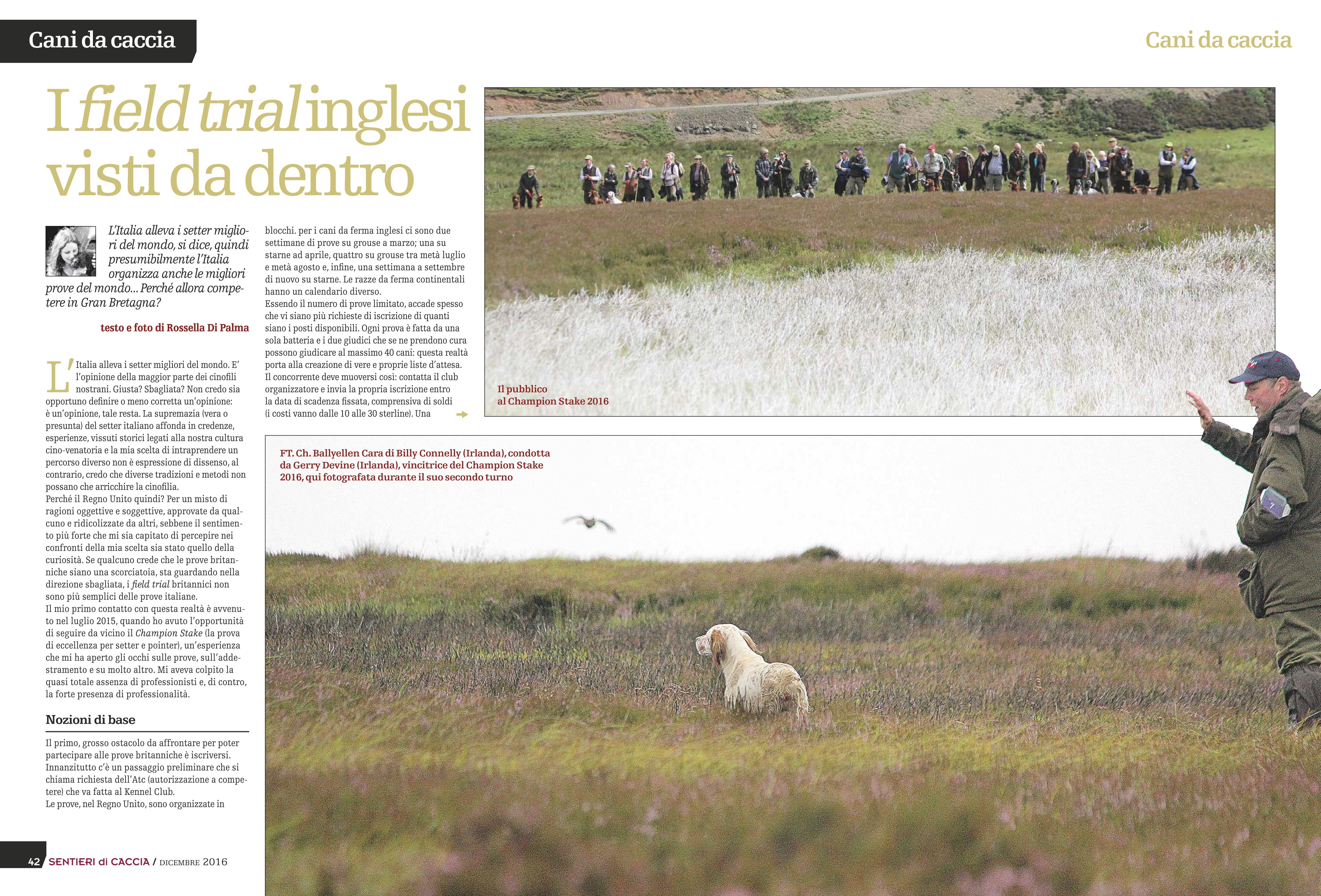
British Field Trials: What’s Inside (Sentieri di Caccia December 2016)
British Field Trials: What’s Inside – Originally Published in Sentieri di Caccia December 2016
Disclaimer: This is the second of a series of articles I wrote for the Italian press. I wrote this article for Italian readers, this means that British people are not going to learn anything new from these pages and, whereas I did my best to be accurate, they may even find some inaccuracies. If so, please notify me. The first article of the series can be found here.
Italy breeds the best English Setters in the world, so presumably Italy also organizes the best field trials in the world, if so… why go to compete in Great Britain?
What you just read above is the widespread Italians opinion on the matter. Are they right? Are they wrong? This is an “opinion”, hence I do not think it can be right or wrong, it is simply an opinion. The true, or presumed, supremacy of the Italian English Setter is rooted in our culture, our believes and our tradition about hunting and shooting. Is my choice to compete in the UK an expression of dissent? No, or rather not completely, as I firmly believe that experiencing different methods and traditions can enrich dogs, hunting and trials.
But why the UK? For a whole bag of reason, some objective and some subjective; some widely accepted and some widely ridiculed. Some accused me of taking a shortcut,t as if British trials were much easier than ours. Wrong assumption! British field trials are NOT easier than Italian ones! I first met this reality in 2015 when I had the opportunity to watch the Champions Stake for Setters and Pointers. This was an awakening, James Joyce would have called it an epiphany, it was one of a kind experience which opened my eyes about field trials and training. Some of my readers probably remember what I wrote at the time, underlining that despite the lack of “professional” handlers, everybody was very “professional”.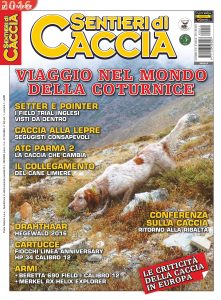
A few hints
The first problem you have to face, if you want to compete in the UK, is entering a trial. Before you can even send your application, you have to get an ATC (Authorization to Compete) number from the Kennel Club. Then you have to understand when the trials take place: in Great Britain, trials take place only in specific period s of the year. There are two weeks of grouse trials in March; one on partridge in April; four on grouse in July/August and, finally, one more week on partridge in September. This is how things are organized for British Pointing Dogs, HPRs (Continental Pointing Dogs) follow a different calendar. Being the number of trials fairly limited (at least if compared to the hundreds of trials taking place in Italy each year), it often happens that there are more perspective competitors than available places. Each trial features only one stake (in Italy many stakes can take place simultaneously, on nearby grounds) and it is judged by two judges who can evaluate up to 40 dogs. As you can imagine, waiting lists are common and so are dogs put on “reserve”, ready to run if a another competitor retires. To enter a trial, competitors must contact the organizing club before the deadline and send the entry form together with the money (prices can range between 10 and 30 pounds). The club secretary will take care of everything and create a list giving priority to the club’s members and to dogs who had already had placement in British trials. As you may see, it is not easy for a foreign newcomer to get a run. In my limited experience, however, I learnt that usually Scottish trials are less popular and that the Novice Class is sometimes easier to access. When possible, moreover, is always good to show up at the trial venue because some competitors might retire their dogs right before the trial. As for becoming a member of the clubs, it can be done but it might take up to a year the formal sponsorship by two former members and meeting you face to face. Each club usually organizes two days of trials, one for the Open Stake and one for the Novice or for the Puppy Stake. The latter is open to dogs under 2 years of age. Dogs who had never placed 1st or 2nd but are older than 2 years can run in the Novice Stake. The Open Stake, instead, is open to any dogs (and compulsory for dogs who placed 1st or 2nd ) but dogs who had previously been graded are more likely to get a run. I managed to compete both in Novice and in Open and I watched some Puppy Stakes: rules are identical for any of these stakes but judges can be “kinder” towards dogs competing in Novice and Puppy.
I liked almost all the dogs competing in the Open Stakes: most of them were good and well trained specimen, the overall level was high. As for the Novice Stakes, I saw good and perfectly trained dogs but also some dogs who still needed more experience and more training, some of these dogs, nevertheless, possessed the natural qualities to do very well in a Open Stake. As for the Puppy Stakes, they were quite unpredictable but I really loved seeing people being brave enough to run young pups, some of them were not even one year old: I really enjoyed watching these stakes.
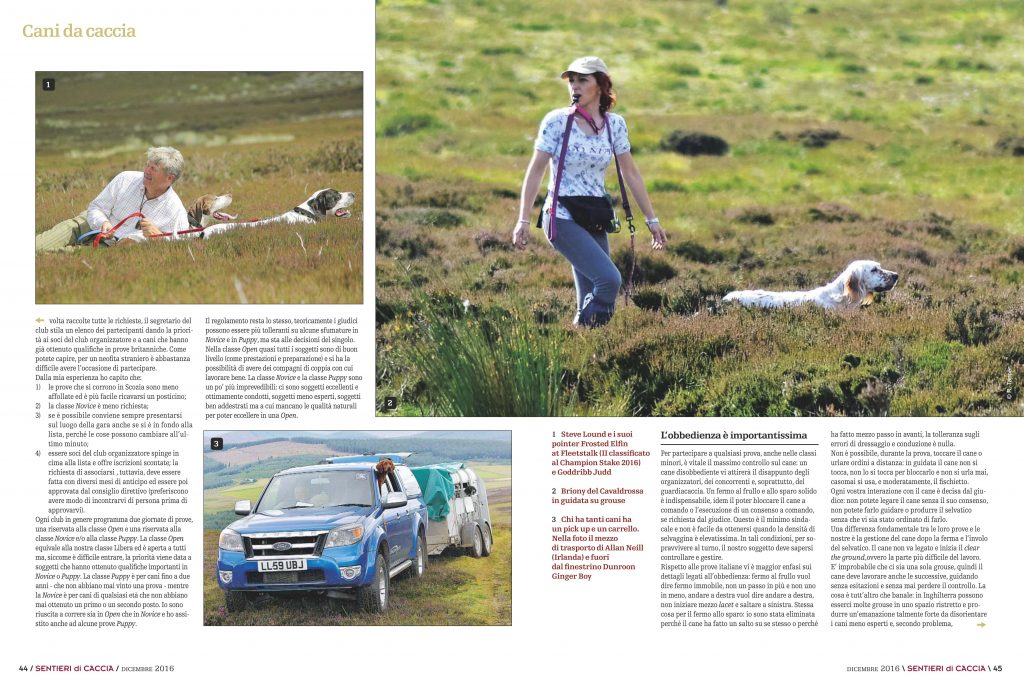
Obedience is extremely important
To compete in British trials (even in the Novice and Puppy Stakes), it is vital to have a good control on your dog. Dogs who ran away and disobey are not appreciated, they might make organizers and other competitors unhappy but, most of all, they will alarm gamekeepers. Dogs must be very steady to flush and shot and drop on command. Judges can also ask you to drop your dog while his bracemate is on point: some British dogs are not naturally backers, so the judge can ask competitors to drop dogs on command. These skills are not negotiable and it is not easy to obtain these behaviour when a dog is surrounded by grouse. Game density can be incredibly high, the dog must be under control and have quite an amount of self control. If we want to compare these trials to the Italian ones, judges pay much more attention on obedience: steadiness to flush means not moving at all, a dog cannot even attempt to step forward or jump on himself; turn left means turn left and so on. The same is true for steadiness to shot, I have been eliminated a couple of times because Briony moved or jumped on herself after the shot, excitement can lead to this, but does not make it more tolerated. During a trial you are not allowed to yell, nor you can touch the dog. You can moderately use the whistle to direct or drop the dog, but you cannot touch him unless and until the judge orders you to put the lead on. You cannot encourage your dog to road and produce the bird by touching him: this behaviour would lead to an elimination. The judge tells you how to interact with the dog: you have to wait for him to tell you that you can let your dog produce the bird; that you can pick him up or that you have to drop him. The biggest difference between our trials and British trials, however, is likely to be the behaviour judges expect after the dog has been shot over. In our trials we usually put the lead on and then maybe cast the dog again, if there is still time (our runs last 15 minutes), in Britain, after the birds have been flushed and a shot fired, the dog is supposed to “clear the ground” making sure there are no grouse left. Given the amount of game (you can read more about this here), it is unlikely that the dog pointed only one, or a few grouse, more grouse, maybe part of the same covey, might still be there and the dog has to work them properly. He should road and flush them, keeping his enthusiasm at bay but, most of all, without hesitation. This is not easy, many birds sitting tight together can produce a strong scent which can confuse the less experienced dogs, at the same time they might be incredibly tempting. Clearing the ground is not always easy, it happened to me to find several grouse during a clear the ground some of which were bold enough to fly straight into the dog’s face, a tough way to test for steadiness.
Each stake is judged by two judges and a dog, in order to be graded, must run twice: this, together with the clear the ground (that does not exists in our trials), increases the likelihood of mistakes being made. If you are still thinking that British trials are “easy”, let me tell you that the mistakes made during the run’s first minute – which are not taken in account in our trials – can lead to an elimination in the country ruled by Queen Elizabeth II. Hare and rabbit shall not be forgotten and, together with the abundance of grouse, make obedience incredibly important. The Italians main focus are the dog’s natural abilities and, therefore, they might be shocked by seeing so much importance given to obedience. Some of my countrymen think that focusing so much on these kind of details you risk to forget the whole picture. It can happen, indeed, but at the same time, obedience and trainability shall never been undervalued. While discussing the Italian version of this article with a British handler told me that, whereas he understood and partly agrees with the Italian point of view, “not selecting for a trait, in the long run, leads to a selection against this trait”. These were his exact words and I agree on them, my ideal evaluation, indeed would be something in between the two systems.
Let’s now talk about practicalities: you are expected to reach the venue ON TIME and drive a proper off road 4×4 car. Nobody has a huge van, it will not be of any use; people with many dogs have a pick up truck and a dog trailer. You might have to cross streams or drive on rocks, a normal car cannot do that. Lunch is eaten on the moor and you have to bring your own lunch (in Italy the venue is usually a restaurant and you go to eat there after the trial). Once the stake starts, people are allowed to follow on foot with the dogs kept on lead. As you can end up walking for hours in a mutable – and often windy- weather, it is advisable to carry with you all the clothes you might need. High heather, cracks and quicksand make the grounds demanding for the dogs and for you as well. All competitors are expected to remain until the end of the trials, when the awards are given. If, for a valid reason, you need to leave the ground in advance, you have to ask permission to the organizers and let them know when you are leaving. A steward of the beat coordinates what happens on the ground supported by one or more gamekeepers and a gun (the person who shoots the produced bird – without killing it). The gamekeepers present at the trials are the same people who take care of the moor all year round, hence they want to be sure that dogs and people do not harm the wildlife they protect. Trials are run in private estates which are generously lent to the clubs, competitors must respect the grounds and the wildlife: dogs out of control are not welcome and can put you under a bad light as well as put organizers in a bad position.
More on the differences between Italian and British trials can be read here.
The Puppy Derby and the Champion Stake 2016
In the summer of 2016 I watched and ran in many field trials that took place in Northern England (Durham County and North Yorkshire) and Scotland (Highlands & The Borders), here I am telling you about the Puppy Derby and about the Champion Stake only. Those who want to know more about dogs and grouse can follow my blog www.dogsandcountry.it , the section “A Month on the Moor” is entirely dedicated to my month among heather. In 2016, the Puppy Derby and the Champion Stake were organized by the SFTA (Scottish Field Trials Association), a big club whose president is Wilson Young and whose secretary is Jon Kean. Jon is a journalist as well and writes on dogs and shooting, he trusted my skills enough to let me follow both the trials closely, I am grateful for that. The Puppy Derby took place on 9th August at Tollishill Estate, owned by the Duke of Northumberland, and located near Lauder (a small village not too far from Edinburgh, on the Borders between Scotland and England). Whereas the catalogue listed 30 dogs, only 9 actually ran in the Puppy Derby. This trial is open to dogs under 2 years old: I do not know why the numbers dropped so dramatically, it might have been caused by a kennel cough epidemic or by the fact that some pups were still not ready to compete. Many of the competitors were about one year old and certainly paid a high price for their lack of experience; hare coming from every direction further complicated things. Billy Darragh and Colin Forde (Ireland), who judged the trial, could only grade one dog, Ballyellen Tango, English Setter dog aged almost two, owned by Billy Connelly (Ireland) and handled by Gerry Devine (Ireland), Gerry is one of the few professional handlers. Whereas only one dog could be graded, I saw some interesting specimen as far as natural qualities, I especially liked two English Setters and I hope to have a chance to see them at work again when they will be more experienced.
On 10th and 11th August, we moved to Byrecleugh Estate, still close to Lauder, kindly offered by the Duke of Roxeburghe. The Champion Stake is a special trial that takes places every year: only the dogs who had gained a 1st or a2nd placement in previous trials (Open Stake) are allowed to run. This year something new was going to happen: the trial would have been judged by three judges, no longer by two. The chosen ones were Meryl Asbury, Shaun McCormack and Michael Houston, the latter two were from Ireland. They were going to see 37 dogs, less than expected due, again, to the kennel cough epidemics. On the morning of the 10th, many dogs made mistakes which lead to their elimination. The first braces ran in very high heather, grouse were well hidden and walking away from them, flying from a distance; later in the morning grouse density decreased and things became slightly easier. In the afternoon we had a torrential rain, but many dogs did extremely well in those conditions (Photogallery for the day here). Only 14 dogs “survived” day 1st and 7 of them, I allow myself to be partial sometimes, were English Setters! On the 11th, all the survivors exhibited outstanding performances, confirming to the judges that they had made wise choices (Photogallery for the day here). I really appreciated how the judges directed the trial, they worked together in harmony and always sided with the dogs, never against them. They were incredibly supportive and really did their best to give the same opportunities to all the dogs and sometimes closed an eye on minor details. Having three judges (one on the left, one on the right and one in the centre) made this trial slightly different. The dogs were allowed to run further and wider and what happened was not much different from what I am used to see here in Italy. When allowed some more freedom, these dogs were still doing very well and were not inferior to most of the Italian dogs I routinely see at our trials.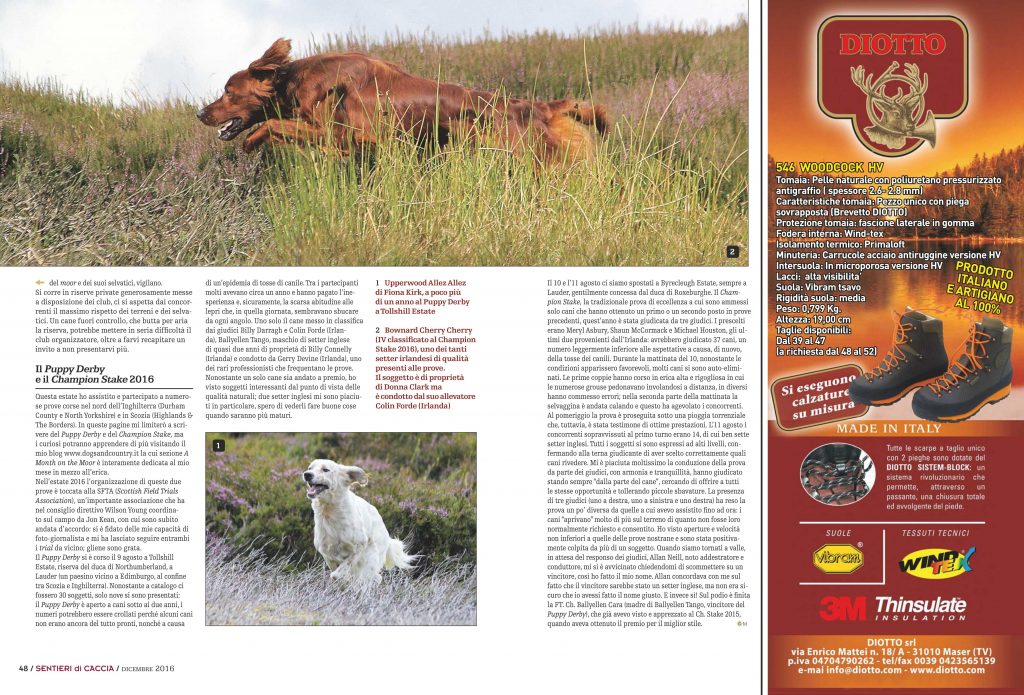
Once back at the venue, Allan Neill, a very reputable trainer and handler from Ireland, asked me to tell him which dog was going to win in my opinion. You were close to the dogs, he added, so you should have seen everything well and have an opinion. Without hesitation, I made a name, Allan agreed upon the fact the winner was going to be an English Setter, yet he was not sure it was going to be the dog I named. But… I was right! FT.Ch. Ballyellen Cara (mother of Ballyellen Tango, who won the Puppy Derby) placed first: her run was unforgettable and she surely possesses some great qualities, I remembered (and liked) her from Champion Stake 2015, at the time she was eliminated but given awarded as the most stylish dog on the ground.
Champion Stake 2016
I° FT. Ch. Ballyellen Cara English Setter bitch owned by Billy Connelly (Ireland), handled by Gerry Devine (Ireland)
II° Frosted Elfin at Fleetstalk English Pointer dog, owned by Steve e Sharon Lound and handled by Steve Lound
III° Hunshigo Donard Irish Setter bitch owned and handled by Mark Adams (Ireland)
IV° Bownard Cherry Cherry Irish Setter dog owned by Donna Clark and handled Colin Forde (Ireland)
Certificates of Merit: Upperwood Clover and FT Ch. Upperwood Hera English Setter bitches owned and handled by Dom Goutorbe and Upperwood Ash Alert English Setter bitch owned and handled by David Hall
The organizers would like to thank the sponsor Red Mills.
Slideshow below
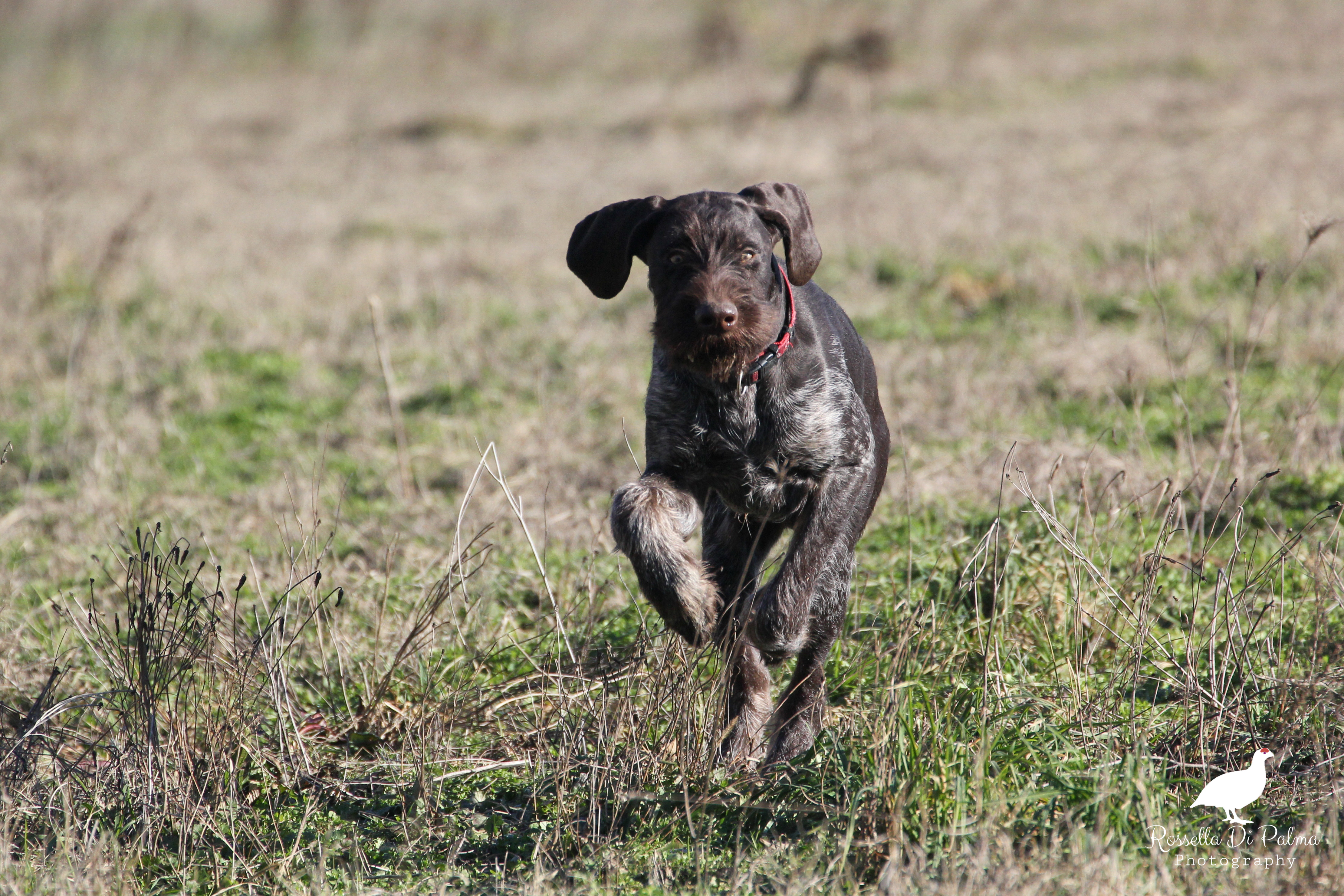


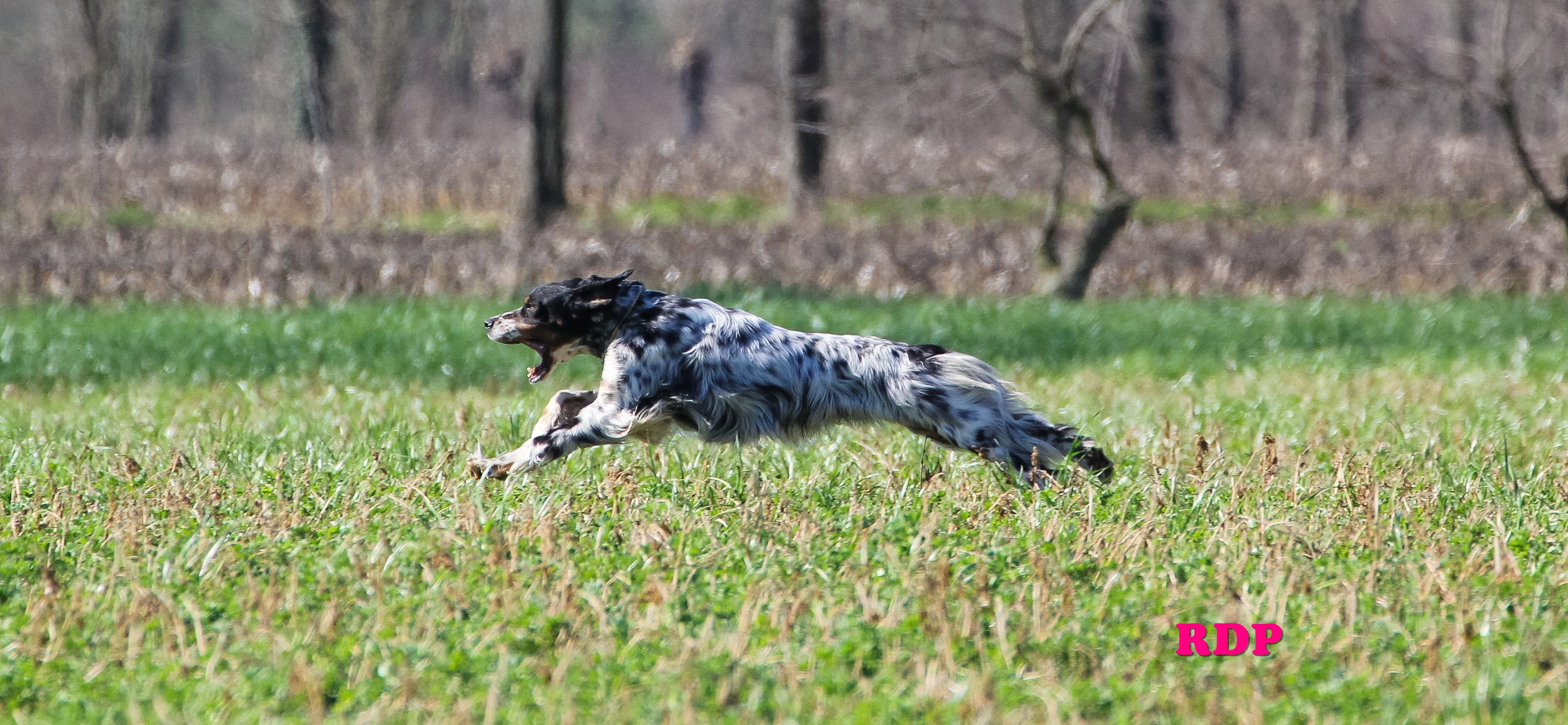
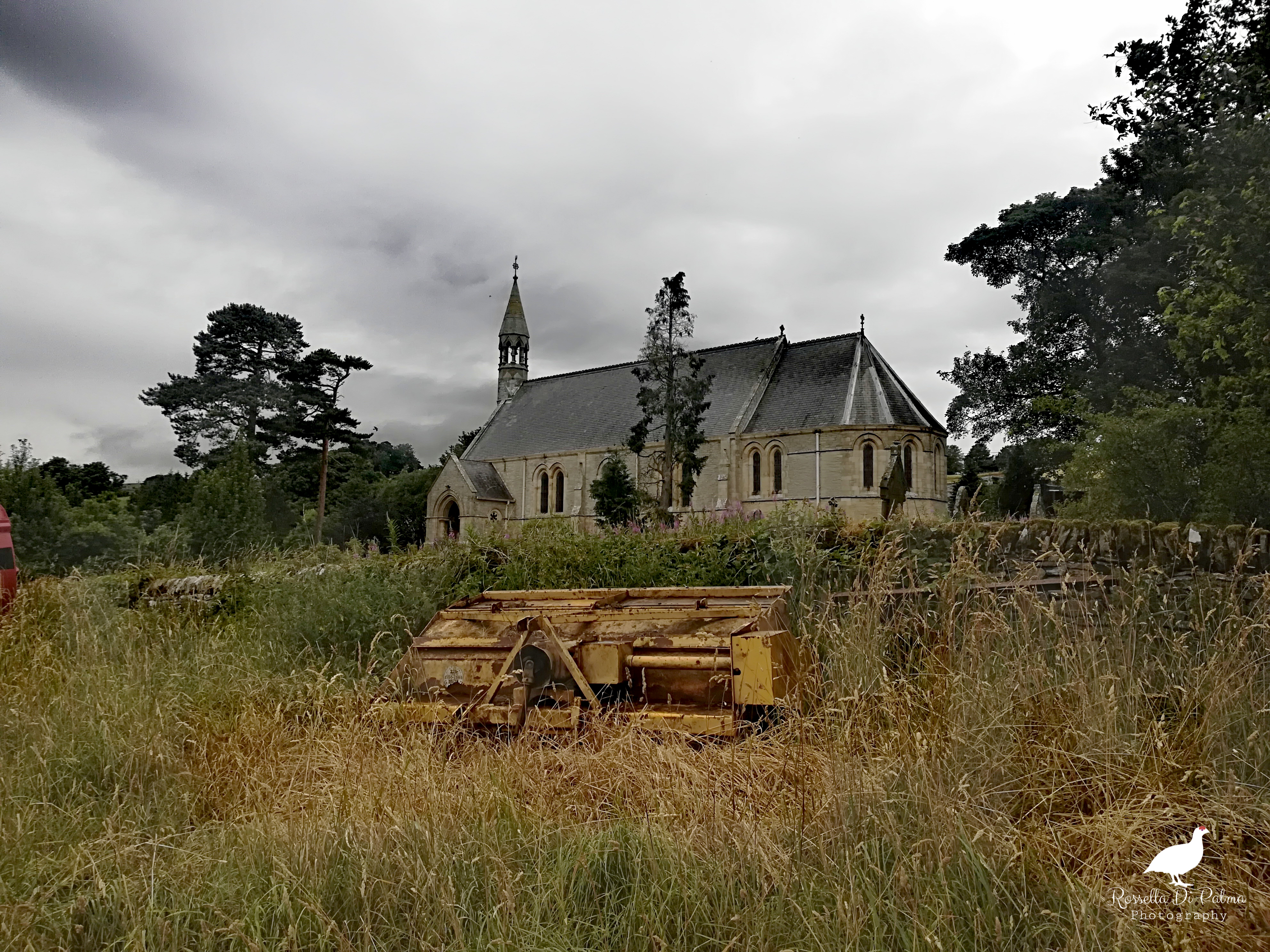

5 commenti
Pingback:
Pingback:
Pingback:
Pingback:
Pingback: